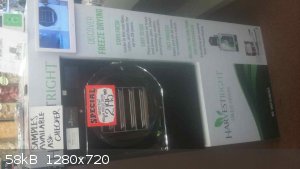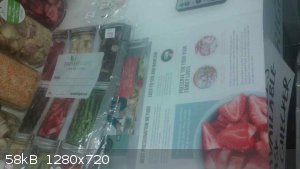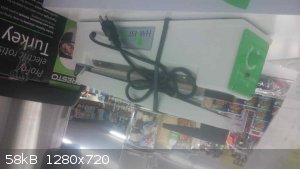Kugel Bauer
Harmless

Posts: 2
Registered: 19-1-2017
Member Is Offline
Mood: No Mood
|
|
Water Aspiration Food Dehydration
Howdy yall, new to posting, long time reader here.
I'm looking into freeze drying fruits and vegetables and see most people using a pump and cold trap to remove vapor to prevent the pump oil from
emulsifying. I am instead planning to use a water aspirator.
Looking at the phase diagram for water, an aspirator should be able to pull down to just above the triple point if the recirculating liquid (RL) is
kept cold. My understanding is that the temperature of the RL is the determining factor, because a hot RL will itself vaporize in the aspirator and
limit max vacuum.
Correct me if I'm wrong here. If the RL is kept at or near freezing, but the dehydrating target (strawberries, okra, etc) is kept at or above room
temperature, then around 15mmHg/20mbar the system should function, right? That would just mean keeping some ice in the RL and warm water around the
vacuum flask.
If so, that limits the functionality to only targets above freezing which makes me pose the following question as well.
Are there any solutes which alter the phase diagram for water? Specifically, would table salt or propylene glycol, which lower the freezing point,
added to the RL change the phases or would the RL water still just boil out at pure water's normal phase temp/pressure?
|
|
|
Maroboduus
Hazard to Others
  
Posts: 257
Registered: 14-9-2016
Location: 26 Ancho Street
Member Is Offline
Mood: vacant
|
|
These things will reduce the vapor pressure of the water at any given temperature.
I believe the organic choices like the glycols would be more effective than most inorganic salts, but don't know if they would beat saturated zinc or
calcium chloride.
You could always use straight ethylene glycol, or mineral oil, or some other low vapor pressure liquid. Dow makes some low viscosity silicone fluids
which would probably be great for low pressures, but they're kinda costly.
Obviously, for these non-aqueous liquids you'd have to cool them indirectly as opposed to just dumping ice in. Those 'blue ice' cold packs would solve
that problem and give a lower working temperature than ice anyway.
However the temperature of the RL might not have to be that low. Might even be able to use a heat exchanger and fan to do the trick if the right RL is
chosen. In that case the cooling would just be to counteract the heating from all the work you're putting into the liquid.
Do they have oil-less pumps that would give you a low enough pressure? Not sure, but somebody on here will be able to fill you in on that.
Freeze drying is generally associated with high vacuums, but it happens at any pressure in a dry environment(albeit MUCH more slowly).
That's why your ice cubes shrink in a frost-free freezer if they're left sitting in there for a really long time.
EDIT, added comment/question: Do mercury diffusion pumps work on the same principle? I have always assumed they do, but I've never even operated one.
This would be way too expensive for your project most likely, but I just wanted to put the question out there since this thread will attract posters
who know the answer.
[Edited on 20-1-2017 by Maroboduus]
[Edited on 20-1-2017 by Maroboduus]
|
|
|
Kugel Bauer
Harmless

Posts: 2
Registered: 19-1-2017
Member Is Offline
Mood: No Mood
|
|
I'm not aware of an oilless vacuum pump that wouldn't be wrecked with large amounts of water vapor.
I have an ice maker so getting ice isn't a problem and there really wouldn't be any reason not to run the RL as cold as possible.
As far as solutes, salt is cheap and PG is probably the next cheapest. Water as the RL is preferable because the vapor extracted mixes right in,
whereas it may just emulsify with mineral oil or any glycol.
Freeze drying anything that is pre-frozen (astronaut ice cream) would require a different RL from pure water which is why I question phase changes for
salt water. You hit a hard stop at the triple point. That would just be for fun though, the primary use will be fruits and veggies.
|
|
|
Maroboduus
Hazard to Others
  
Posts: 257
Registered: 14-9-2016
Location: 26 Ancho Street
Member Is Offline
Mood: vacant
|
|
Quote: Originally posted by Kugel Bauer  | I'm not aware of an oilless vacuum pump that wouldn't be wrecked with large amounts of water vapor.
Freeze drying anything that is pre-frozen (astronaut ice cream) would require a different RL from pure water which is why I question phase changes for
salt water. You hit a hard stop at the triple point. That would just be for fun though, the primary use will be fruits and veggies.
|
I'm not aware of an oil-less vacuum pump which WOULD be wrecked by the vapors from freeze-drying foods(although I'm sure there must be such things,
none of the ones I am familiar with have such limitations). Many varieties and brands of oil-less pumps are used for just that purpose(evaporating
water).
The fact that freeze-drying foods would require something better than an aspirator with water is obvious, even without your having pointed it out in
your first post.
I would have thought the fact that salt changes the vapor pressure and freezing point of water would be equally obvious, especially for anybody who
uses terms like triple point. If not, then I can assure you that it does. This should have been clear from my previous post.
The calculations needed to determine the magnitude of these changes are available in any high-school chemistry textbook.
EDIT: And as one might expect from the name, propylene glycol is in fact a glycol.
[Edited on 20-1-2017 by Maroboduus]
[Edited on 20-1-2017 by Maroboduus]
[Edited on 20-1-2017 by Maroboduus]
[Edited on 20-1-2017 by Maroboduus]
|
|
|
jack44556677
Harmless

Posts: 7
Registered: 20-1-2004
Member Is Offline
Mood: No Mood
|
|
Hey! I'm thinking the same thing, re using an aspirator pump to freeze dry if possible!
It seems the "right"/commercial way to freeze dry things is most commonly a vacuum (sometimes NOT vacuum!) desiccator which is a much glorified
shamefully overpriced box with a heater, some trays, and sometimes a fan (if you ponied up for the DELUXE model). It seems this works well enough for
most things, and actual sublimation is either not necessary or an extremely similar (if not identical) product can be produced with lesser vacuum (or
no vacuum) over longer periods of times and/or at lower temperatures. Another commercial method of freeze drying involves allowing dry ice to
constantly evaporate from underneath the thing to be freeze-dried. The CO2 gas wicks away water with it, aided by the extreme cold, and could be done
in a pipe or a Styrofoam cooler.
The guy who made astronaut ice-cream went with a homemade cold trap of copper tube in a thermos full of dry ice and acetone and/or isopropyl alcohol (
he also used a serious vacuum pump, but regardless the cold trap should allow you to pull vacuum beyond the vapor pressure of the water being used in
the aspirator ). Even with the more powerful (compared to an aspirator even with 0C water running through it) vacuum pump and cold trap, the energy
required to facilitate the sublimation is significant and wouldn't happen without a decent powered heat lamp shining full blast onto the ice cream in
the vacuum flask.
In musing and searching the web on this topic I came across a paper from a lepidopterist group from the 70's. Specifically it was being suggested
that the water aspirator coupled with standard desiccants was ideal for freeze drying moth larvae for the average person because they already have a
faucet and freezer, the aspirator itself costs around $20, and the whole kit weighs less than a pound and can be brought with you on expedition.
http://images.peabody.yale.edu/lepsoc/jls/1970s/1976/1976-30(4)277-Hedges.pdf
The reasoning on why this freeze-drying process worked was very interesting, and I'm hoping someone here can chime in with thoughts on how (un)sound
it is :
It posits that though we certainly COULD generate an extreme vacuum to reach the triple point (or beyond) of water and then add heat to cause
sublimation; this is only something you do when you are in a hurry. Because the vapor pressure (of water, ice, or a combination of the two) is
primarily dependent on the temperature, "sublimation" in the form of evaporation is occurring at all times and a simple desiccant box will remove
nearly all of the water within a sample assuming enough desiccant and time. It was found by the author of the paper that by freezing the sample
(insect larvae) thoroughly in a desiccant chamber, applying vacuum by water aspirator for less than a minute, and throwing the evacuated desiccant jar
back in the freezer for at least 24 hours fully freeze-dried the samples. It was described in the paper that the reason this works is because the
vapor pressure is always attempted to be restored based on the temperature of the sample, and the desiccant keeps removing the vapor which upsets the
equilibrium which causes more vapor to evaporate from the sample. The vacuum supposedly helps the speed of the vapor pressure equilibrium cycle
because there is no / or much lesser opposing pressure against the vapor pressure from the ice in the jar. You could just throw the sample in the
desiccant jar in the freezer with no vacuum and wait longer, but if the paper (and other anecdote) is to be believed then the affect of the vacuum is
extreme. What might take a month without vacuum would complete full desiccation in 24 hours. The paper also goes into the desiccant choice as this
has a bearing on the ultimate dryness achievable.
The basic principle of "freeze-drying" as it has been explained to me, involves skipping the liquid phase more than anything else, and it would seem
that both keeping the sample frozen (not allowing any thawing) in a desiccant chamber (with or without vacuum to speed up the process) or changing the
pressure radically enough so that the liquid phase is skipped entirely on heating are functionally equivalent in regards to getting the water out of
the sample by going directly from ice to water vapor and skipping the liquid water phase. A couple of quick glances at the phase diagram for water (https://commons.wikimedia.org/wiki/File hase_diagram_of_water.svg) and the
vapor pressure of ice chart (https://web.archive.org/web/20170319072040/https://www.lyote...) appear to show that this all makes sense.... Can someone here see the error, if
any? hase_diagram_of_water.svg) and the
vapor pressure of ice chart (https://web.archive.org/web/20170319072040/https://www.lyote...) appear to show that this all makes sense.... Can someone here see the error, if
any?
Does anyone know how to prevent the desiccant (or any powder thereof) from interacting with food? I tend to use calcium chloride, but that stuff is
also used to sterilize mammals...
Anyhow, maybe the dream of using the aspirator (in combination with a desiccant and freezer) might just be a viable freeze drying option!
[Edited on 9-4-2019 by jack44556677]
|
|
|
andy1988
Hazard to Others
  
Posts: 135
Registered: 11-2-2018
Location: NW Americus ([i]in re[/i] Amerigo Vespucci)
Member Is Offline
Mood: No Mood
|
|
Quote: Originally posted by jack44556677  |
It seems the "right"/commercial way to freeze dry things is most commonly a vacuum (sometimes NOT vacuum!) desiccator which is a much glorified
shamefully overpriced box with a heater, some trays, and sometimes a fan (if you ponied up for the DELUXE model). |
Saw this at my local hardware store (attached photos). Vacuum pump oil in this one. Long term food storage is popular here.
Thank you for sharing that low cost vacuum freeze-drying paper.
Quote: Originally posted by jack44556677  |
Does anyone know how to prevent the desiccant (or any powder thereof) from interacting with food? I tend to use calcium chloride, but that stuff is
also used to sterilize mammals...
|
FoodSaver jar sealer? Food in mason jar A, desiccant in mason jar B. 3-way hose barb between for drawing vacuum, and valve between vacuum source
(aspirator) and 3-way hose barb allowing for disconnect. Use vinyl tubing.
Draw vacuum.
Close valve and disconnect from vacuum.
Place connected mason jars in freezer (and hope thermal coefficient of expansion in materials doesn't lead to loss of vacuum).
Repeat procedure as needed?
Remove FoodSaver jar sealer, mason jar lid will seal with mason jar leaving the freeze-dried food stored at the vapor pressure of whatever
recirculating liquid you used (or a bit above that pressure, but roughly that). Less oxidation possible in comparison to the attached
photographed system, allowing for longer storage & better taste.
Sorry I didn't respond earlier, I took these photos meaning to respond a year ago but forgot. Found these photos again.
    
[Edited on 3-6-2020 by andy1988]
|
|
|
|